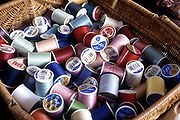
Thread (yarn)
Encyclopedia
Thread is a kind of yarn
used for sewing.


The most common weight system specifies the length of the thread in kilometers required to weigh 1 kilogram. Therefore, a greater weight number indicates a thinner thread.
American standard of thread weight (wt) was adopted from Gunze Count standard (Japan)..
Gunze Count standard uses two numbers separated by a forward slash. The first number indicates the weight of the internal threads and the second number indicates the number of threads wrapped together to make the finished thread. It is common to wrap three strands of the same weight to make one thread (as indicated in the chart), any number of strands may be used and sometimes only two strands are wrapped together to made the finished thread. The American standard drops the specification of the number of strands which are twisted together. Therefore it is does not accurately describe thread.
Yarn
Yarn is a long continuous length of interlocked fibres, suitable for use in the production of textiles, sewing, crocheting, knitting, weaving, embroidery and ropemaking. Thread is a type of yarn intended for sewing by hand or machine. Modern manufactured sewing threads may be finished with wax or...
used for sewing.

Materials
Thread is made from just about everything. Following table lists common materials, a general description and what they are supposed to be good for. If your machine will sew with the thread, any thread can used for just about any purpose. This is very useful for someone who is trying to learn sewing. Please improve/expand this table.
| Material | Description | Purpose |
|---|---|---|
| Cotton Cotton Cotton is a soft, fluffy staple fiber that grows in a boll, or protective capsule, around the seeds of cotton plants of the genus Gossypium. The fiber is almost pure cellulose. The botanical purpose of cotton fiber is to aid in seed dispersal.... |
spun traditional thread | general |
| Cotton/Polyester Polyester Polyester is a category of polymers which contain the ester functional group in their main chain. Although there are many polyesters, the term "polyester" as a specific material most commonly refers to polyethylene terephthalate... |
A cotton thread with a polyester core which is slightly stretchy but retains the traditional look of cotton | strength without sheen |
| Fusible | Fuses sewn fabrics together when ironed | binding and appliqué |
| Metallics | A delicate metallic coating protected by an outer coating providing extremely vibrant color/glitter and/or texture. | decoration |
| Nylon Nylon Nylon is a generic designation for a family of synthetic polymers known generically as polyamides, first produced on February 28, 1935, by Wallace Carothers at DuPont's research facility at the DuPont Experimental Station... |
A transparent monofillament which can be melted by an iron. Nylon is usually weaker than polyester. | strength with transparency |
| Polyester | A synthetic blend which is stronger and stretchier than cotton with little or no lint (may be texturized) | strength |
| Rayon Rayon Rayon is a manufactured regenerated cellulose fiber. Because it is produced from naturally occurring polymers, it is neither a truly synthetic fiber nor a natural fiber; it is a semi-synthetic or artificial fiber. Rayon is known by the names viscose rayon and art silk in the textile industry... |
Made from cellulose Cellulose Cellulose is an organic compound with the formula , a polysaccharide consisting of a linear chain of several hundred to over ten thousand β linked D-glucose units.... , but not considered to be a natural fibre because it is highly processed. Useful for obtaining bright colors. |
appearance |
| Silk Silk Silk is a natural protein fiber, some forms of which can be woven into textiles. The best-known type of silk is obtained from the cocoons of the larvae of the mulberry silkworm Bombyx mori reared in captivity... |
A very fine, strong and hard to see thread. | attaching beads |
| Wool Wool Wool is the textile fiber obtained from sheep and certain other animals, including cashmere from goats, mohair from goats, qiviut from muskoxen, vicuña, alpaca, camel from animals in the camel family, and angora from rabbits.... |
A thicker thread. | homespun look |
| Water Soluble Solubility Solubility is the property of a solid, liquid, or gaseous chemical substance called solute to dissolve in a solid, liquid, or gaseous solvent to form a homogeneous solution of the solute in the solvent. The solubility of a substance fundamentally depends on the used solvent as well as on... |
Dissolves when washed | temporary basting |
Common
Weight is a way of indicating the thickness of a thread.The most common weight system specifies the length of the thread in kilometers required to weigh 1 kilogram. Therefore, a greater weight number indicates a thinner thread.
American standard of thread weight (wt) was adopted from Gunze Count standard (Japan)..
Gunze Count standard uses two numbers separated by a forward slash. The first number indicates the weight of the internal threads and the second number indicates the number of threads wrapped together to make the finished thread. It is common to wrap three strands of the same weight to make one thread (as indicated in the chart), any number of strands may be used and sometimes only two strands are wrapped together to made the finished thread. The American standard drops the specification of the number of strands which are twisted together. Therefore it is does not accurately describe thread.
| Weight | Gunze Count | Common Use | |
|---|---|---|---|
| Light | 60 wt | #60/3 | bobbin or appliqué |
| Thin | 50 wt | #50/3 | bobbin or appliqué |
| Regular | 40 wt | #40/3 | Quilting |
| Upholstery | 30 wt | #30/3 | Decorative |
| Heavy | 20 wt | #20/3 | Decorative |

